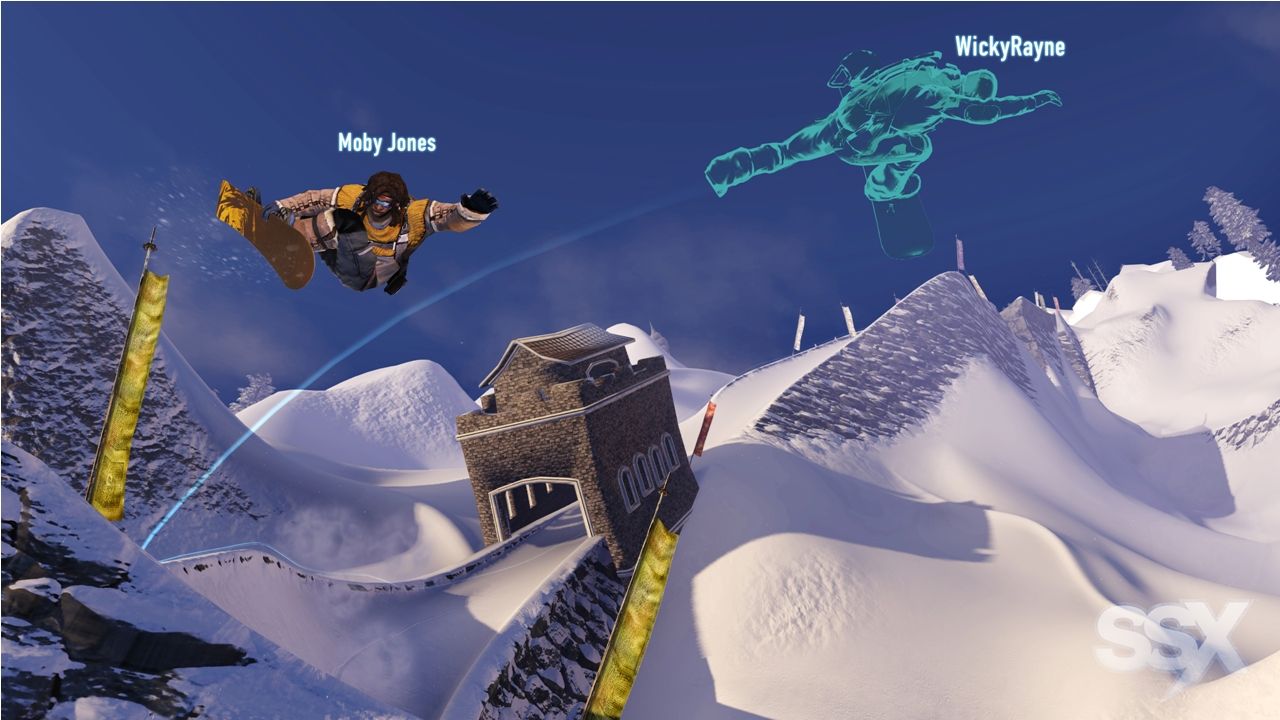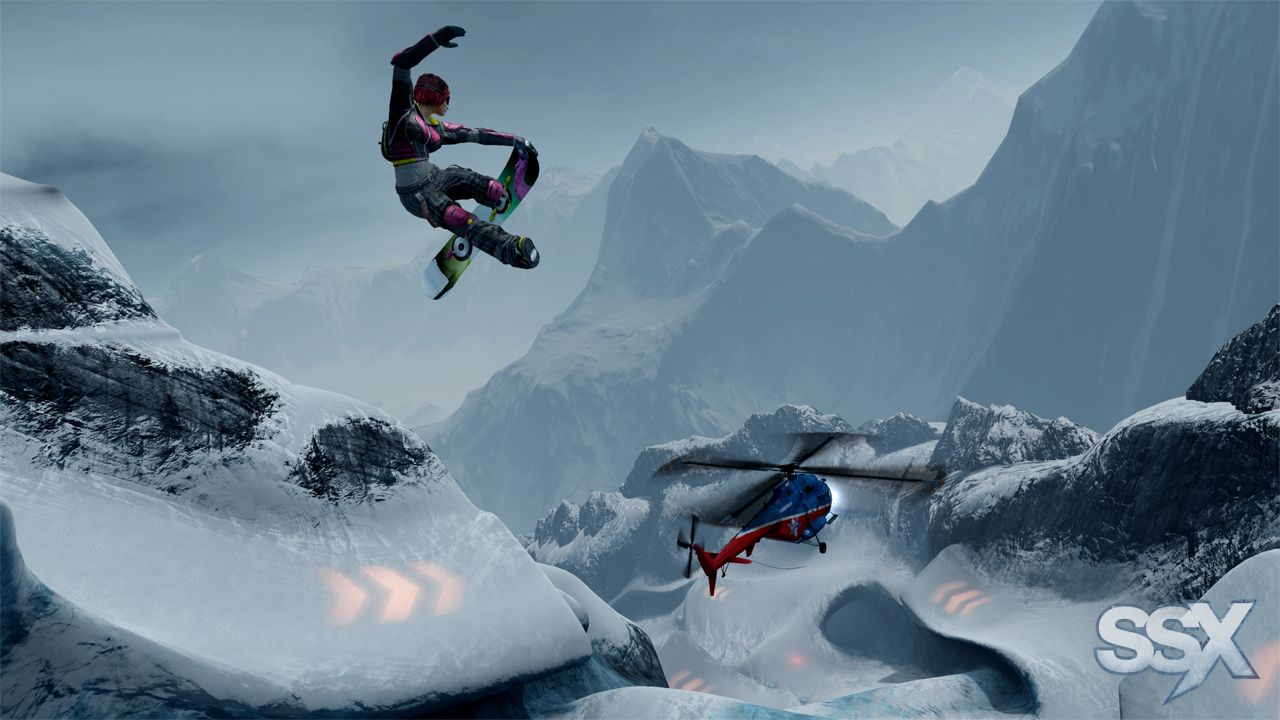SSX Review
A successful reboot for the franchise that ditches local multiplayer in favor of expansive asynchronous options
Following in the newly resurrected footsteps of other arcade-style, over-the-top sports games like NBA Jam and NFL Blitz, EA has resurrected the (mostly) dead SSX franchise that dominated much of last generation’s extreme sports field. First debuting at the 2010 SpikeTV Video Game Awards as SSX: Deadly Descents, the game saw a massive overhaul after fan outcry demanded that the franchise’s signature exaggerated tricks, extreme jumps, and wild environments not be cut in terms of a grittier “Call of Duty” approach. Thankfully, EA Canada listened (while still managing to keep many aspects of their original vision) and what we get is the best of both worlds, old and new.

While many may be familiar with the controls and mechanics of SSX due to franchise familiarity, it has been seven years since the franchise’s last official entry (apparently, 2007’s SSX Blur is non-canon, according to developers). The core concept changes depending on the game mode. In Trick It, the idea is simply to get the highest trick score possible. While the game features classic controls mimicking those exact controls of the previous games in the series, SSX also sports two new control schemes (both of which worked much better in my experience). You now use one button to jump and then a combination of other button taps and holds (or motions with the right analog stick) to execute different tricks. Due to the penalty you take when doing duplicate tricks being more important than the tricks themselves in many cases, tricking is more about variety here rather than having memorized the exact button combo for a specific trick. Each character has a special trick that can only be able to use once they have filled their Tricky meter twice from completing tricks, initiating “Super Tricky.”
In Race It, the goal is to simply score the fastest time possible or beat the other opponents you are racing against depending on whether you are playing in the game’s multiplayer or singleplayer campaign. Here, speed is the primary goal and this is achieved through the delicate balance of completing tricks in order to gain boost (being in Tricky mode grants you unlimited boost) without doing so many tricks and getting so much air that you slow yourself down. It’s an interesting balance act but one that can be frustrating due to the design of many levels which seem to be chock full of holes that force you to rewind when fallen into, effectively requiring a restart of the entire race if going for an especially challenging time.
Survive It is all about complete the level of enduring the level as long as possible with subsequent repeats becoming more and more difficult. These levels are intended to be played much more slowly, usually with the use of some of the game’s special equipment like solar heating packs, pulse goggles, or armor. Rewinds are limited here to essentially force an end to the runs. This makes for a nice change of pace, but I am doubtful that many people would play the game this way primarily. The avalanche levels, which have you playing from a zoomed-out reverse angle (watching yourself go down the mountain from a helicopter view), are really impressive and very high stakes given the unusual camera angle and snow physics involved in creating the actual avalanche.

SSX’s primary focus is undoubtedly its asynchronous multiplayer Explore and Global Event modes. Much akin to the Autolog system first found in 2010’s Need for Speed: Hot Pursuit, these modes utilize RiderNet, a system that constantly tracks your accomplishments, lays them alongside the scores and times of your friends, tracks your progress on a global level, and even suggests new friends for you based on your current skill level. This is a wonderful feature and one that essentially keeps those with any small shred of competition wanting to play constantly. I am not normally a competitive individual but I have found myself time and time again spending hours trying to conquering my friends’ scores since the game’s release. There’s always a time to beat, a trick run to do better on, a global event to join, and a new friend to play with.
While Explore and its RiderNet integration are essentially just really involved leaderboards and ghosts upon which you post all of your scores in the game, SSX’s Global Events are a more active type of competition. In these events, you pay an entry fee (although many of the official EA Global Events are free) and then compete in real-time against every other entrant (similar to Trackmania). These are timed, normally lasting for several days, upon completion of which you received a payout based on how you ranked. The higher you place, the more money you receive based on the total prize pool. These are not only the most fun aspect of the game once you get your bearing across most of the courses, but they are also the best way to snag massive amounts of in-game currency that will allow you to buy all of the most epic gear (and enter even higher stake Global Events).
Graphically, SSX is a solid looking game but there’s little here to marvel at. While wide vistas look great and the UI is really top notch (except for a few too-long animations), a majority of the game looks good enough to stay out of the way of gameplay and nothing more.
Thankfully though, the soundtrack here is stellar. With everything from hip-hop to dubstep to indie rock, the game covers a lot of bases while always sounding like one game, which is a feat that not many games can pull off. On top of the great soundtrack, the game mixes the music along with dubsteppy wub-wubs and a remix of Run DMC’s “It’s Tricky” as you perform crazier tricks and speed down the track. This even works with custom soundtracks imported into the game which is a feature that many music nuts should be sure to take advantage of.

For the first time (at least in my memory), SSX actually has a storyline that is more than just “win the competition” or “become the best snowboarder around,” although honestly, it really doesn’t amount to more than that if you think about it for more than five minutes. Griff, a former SSX character, leaves SSX to conquer the world’s nine deadly descents and become the coolest cool bro dude in all of history. Team SSX, which now stands for Surfing, Snowboarding, and Motocross apparently, won’t stand for it. They must travel across the globe, conquering mountains faster and better than Griff can. It’s a pretty pointless story and one that SSX doesn’t need. It is only hurt by the fact that a majority of character backstories and personalities are conveyed to the player through dreadfully cheesy motion comics and goofy “extreme” cutscenes. That said though, I was happy to see DJ Atomika making a return. He is unquestionably my favorite fictitious video game DJ of all time.
I believe it is worth mentioning, especially since so many other people seem to have an issue with it (at least initially), SSX does not include any simultaneous local or online multiplayer. While these have always been present in past SSX titles, the multiplayer landscape has changed dramatically since SSX 3. While I do miss its inclusion, the times in which I would be playing locally with friends is not nearly as often as I find myself playing RiderNet. I can only assume that EA Canada chose not to include it in order to keep all of the players on RiderNet, rather than fragmenting players between live multiplayer and things like the Global Events. Most of the asynchronous aspects of the game only work well with a large number of players. It is just good to know this ahead of time that way you don’t set aside time to sit down with a friend at home only to realize you won’t be playing anything together.
The one fundamental problem I had with the game is its new rewind feature. For some reason, this mechanic has found its way into a majority of racing titles today, and now it has blended over into other sports as well. In race events, using rewinds only rewinds your character while the rest of the players continue to move forward in time (making it even more difficult to overcome your mistake). In trick events, it is useful when used the first time in a match, allowing you to recover your combo, but any subsequent use not only removes your combo instantly but also knocks you with a serious point penalty (making it more difficult to win). The only place that it really makes sense and works as intended is in the game’s Survive It missions, and there, it doesn’t penalize you, but you are limited to a certain number of uses.
All that said, SSX is one of the most successful franchise resurrections over the past several years. The core mechanics and central atmosphere that made SSX the standard upon which all other snowboarding games were and are judged are all here and for the most part, have been improved (the new control methods) or built upon to create new and interesting experiences (Survive It). While some may miss the lack of simultaneous, local multiplayer, the game’s largest addition RiderNet keeps the activities and incentives coming well past the game’s usual lifespan. Global events, a wealth of gear to collect, and constant competition makes this an SSX that feels simultaneously new and old. For the most part, that is a great thing.
 Comments
Comments



















